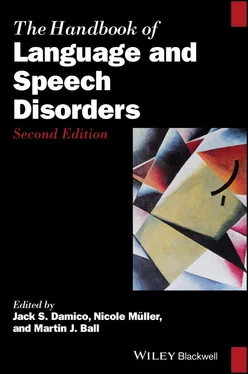There have also been clinical and parental reports, as well as a number of research studies, that have shown that individuals with WS have problems in establishing friendships and have social difficulties, such as disinhibition and social isolation (Davies, Udwin, & Howlin, 1998).
Some studies have shown that individuals with WS are not sensitive to the needs of the conversational partner (Udwin & Yule, 1991). Further to this, Stojanovik et al. (2001) reported a high level of conversational inadequacy in a pilot study of a group of children with WS, in which participants with WS were found to have a tendency not to provide enough information for the conversational partner. Laws and Bishop (2004) reported pragmatic language impairment and social deficits in a group of older children and young adults with WS, using the Children’s Communication Checklist (Bishop, 1998). The checklist ratings showed pragmatic language deficits, evident from inappropriate initiations of conversation, and use of stereotyped conversation. Furthermore, Stojanovik (2006) reported that children with WS have difficulties with exchange structure and responding appropriately to the interlocutor’s requests for information and clarification. They also had significant difficulties with interpreting meaning and providing enough information for the conversational partner. A later, longitudinal study by John, Dobson, Thomas, and Mervis (2012) reported similar findings, in that they found a relationship between children’s pragmatic ability at 9–12 years of age and their earlier secondary subjectivity (i.e., the ability to produce utterances which are paired with eye‐contact).
Lacroix, Bernicot, and Reilly (2007) investigated the abilities of children with WS to interact for the purpose of attaining a goal. The task required the mother and the child to collaborate and negotiate in order to produce a drawing on the computer, on the basis of a drawing model. During this collaborative conversation task, the children and adolescents with WS (similarly to those with DS) produced fewer utterances than the typically developing participants and played a weak role in the conversation compared to their mother. However, they readily expressed their psychological states (like younger children of the same nonverbal mental age). Also, the children and adolescents with WS responded to maternal directives less often than all other groups.
Children with WS also find it difficult to verbalize message inadequacy (John, Rowe, & Mervis, 2009). Using a barrier, listener‐role referential communication task, the child was instructed to follow the researcher’s instructions. The children performed well when the instructions were adequate, but found it considerably more difficult when the instructions were inadequate, that is, when the instructions were ambiguous, or the instruction contained vocabulary the child did not understand, in that they indicated less than half of the time that there was a problem. When they verbalized that there was a problem, the verbalizations were often too vague for the researcher to identify a problem, or they identified the wrong problem. The ability to verbalize message inadequacy was related to the children’s chronological age and theory of mind.
Narrative skills in individuals with WS seem to be poorer than those of mental age‐matched neurotypical controls. For example, despite relative strengths in phonological, lexical, and syntactic abilities, individuals with WS had difficulties with discourse planning and organization, and produced less coherent narratives (Marini, Martelli, Gagliardi, Fabbro, & Borgatti, 2010). This finding is in line with earlier studies which suggested difficulties with pragmatics and discourse processing in individuals with WS (Laws & Bishop, 2004). Poor quality of narrative production in terms of structural coherence and process complexity (compared to chronological age‐matched controls) was also reported in a study by Gonçalves et al. (2010).
In summary, although it is evident that research on WS has moved substantially from the initial claims that individuals with WS have “intact” language abilities despite severe cognitive deficits, the emerging picture is much less clear and the question of the contribution of atypical populations, such as individuals with WS to which constraints guide typical language acquisition, is more open to debate than ever before. The evidence base is growing, however. in the direction of highlighting possible atypical developmental pathways and relative strengths and weaknesses.
5.3 Language and Communication in Down Syndrome (DS)
DS is a genetic disorder caused by a partial or complete duplication of chromosome 21 (Epstein, 1986). It affects approximately 1 in 691 live births (Parker et al., 2010). DS is the most common cause of intellectual disability and seems to be particularly detrimental to language acquisition. A lot can be learnt about language in individuals with DS by reading reports on individuals with WS because people with DS are often included as a comparison group in studies of individuals with WS—individuals with WS and those with DS have similar nonverbal abilities but often different language profiles (Bellugi, Linchtenberger, Lai, & St.George, 2000; Bellugi et al., 1994; Jarrold et al., 1998; Reilly, Klima, & Bellugi, 1990).
As in individuals with WS, the profile of individuals with DS is also often characterized as “uneven” with weaknesses in auditory short‐term memory relative to visual short‐term memory and other aspects of cognition (Chapman, 2003), and with strengths in social functioning abilities (Kasari & Baunminger, 1998).
Language acquisition is a challenge for people with DS, although vocabulary level tends to be less impaired than grammatical abilities (Chapman, Schwartz, & Kay‐Raining Bird, 1991; Miller, 1996). Many children with DS do not acquire their first words before the age of two (Rondal, 2001), but early lexical development generally shows a positive linear relationship with mental age (Rondal & Edwards, 1997). Language performance tends to be lower than expected from their general level of cognitive development (Chapman & Hesketh, 2000; Fowler, Gelman, & Gleitman, 1994; Perovic, 2002; Vicari, Caselli, & Tonucci, 2000), though there is individual variation. In a study of 43 children with DS using the McArthur Child Development Inventory, Miller (1999) reported that 65% of the children scored below their mental age on vocabulary and only 35% of the children had vocabulary ranges that were consistent with their mental age. Compared with typically developing individuals matched for nonverbal mental age, children and adults with DS often have receptive vocabulary deficits (Jarrold, Baddeley, & Phillips, 2002), although some children with DS have similar expressive and receptive vocabulary to typically developing children of the same nonverbal mental age (Laws & Bishop, 2003). In adolescents and adults with DS, receptive vocabulary is usually reported as a relative strength (Abbeduto, Warren, & Conners, 2007) and generally in line with nonverbal mental age. Importantly, receptive vocabulary has sometimes been reported to exceed general nonverbal abilities (Abbeduto et al., 2007; Næss, Lyster, Hulme, & Melby‐Lervåg, 2011).
Only a handful of studies have investigated early language development in DS, hence knowledge on the early stages of language acquisition in DS is still limited. Cardoso‐Martins, Mervis, and Mervis (1985) followed longitudinally 6 children with DS aged 17–19 months at the start of the study, and compared them with 6 typically developing children aged 9 months at the start of the study, investigating the acquisition of object names. There was no difference between the two groups at the start, but the DS group (both comprehension and production) started to lag behind their general nonverbal cognitive skills. This suggests that vocabulary acquisition develops at a slower pace than general cognitive abilities from an early age. Similar findings were reported almost 30 years later by Zampini and D’Odorico (2013) who used the Italian version of the MacArthur–Bates Communicative Development Inventory with 18 children with DS aged between 2 and 3. Specifically, expressive vocabulary was reported to lag behind general cognitive development, with the main changes in vocabulary development occurring at 36 months of age, when individual differences become more prominent. However, different findings were reported in a longitudinal study of expressive vocabulary by Te Kaat‐van den Os, Volman, Jongmans, and Lauteslager (2017) who found that children’s expressive vocabulary skills were related to their nonverbal mental abilities. Similarly, a relationship between receptive vocabulary development and general nonverbal abilities was reported by Cuskelly, Povey, and Jobling (2016).
Читать дальше












